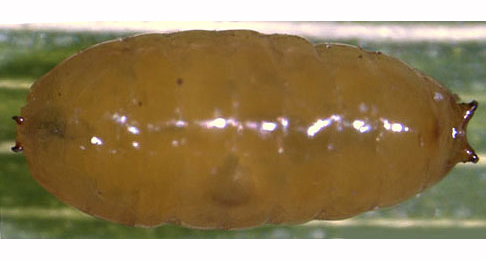|
||||||
|
CICER. Chick Pea. [Fabaceae] |
|
Only one species of Cicer is recorded in Britain, the introduced Chick Pea (C. arietinum). Four Briitish miners are recorded on Cicer. A key to the European miners recorded on Cicer is provded in Bladmineerders van Europa. |
Key for the identification of the known mines of British |
1a > Leaf-miner: Mine linear, whitish, both upper and lower surface. Pupation internal, at the end of the mine with the anterior spiracles projecting through the epidermis (Spencer, 1976: 433). Upper-surface, less often lower-surface corridor. Frass in isolated grains. Pupation within the mine, in a, usually lower-surface, pupal chamber. A long whitish upper surface corridor, which eventually goes lower surface. |
|
Chromatomyia horticola (Goureau, 1851) [Diptera: Agromyzidae]. |
1b > Leaf-miner: An upper or lower surface shallow winding linear mine, which may develop into a secondary blotch. Pupation external (Spencer, 1976: 240). Puparium orange Upper- or lower-surface, greenish or whitish corridor, sometimes a blotch. The corridor does not widen much and is not associated with the midrib. Frass in conspicuous thread fragments, alternating along the sides of the corridor. Pupation outside the mine. The mine is also illustrated in British Leafminers. |
|
Liriomyza cicerina (Rondani, 1975) [Diptera: Agromyzidae]. |
1c > Leaf-miner: Corridor leaf-mine in leaves. An upper surface linear mine with frass in conspicuous greenish strips, largely alternating at each side of the channel (Spencer, 1976: 241). Upper-surface, unbranched corridor, relatively broad from the start on, but only weakly widening subsequently. The fresh mine is bright green, but turns whitish, later brown, quickly. Frass in a wide green band in the centre of the corridor, with small black granules at either side. Pupation outside the mine. Forms an upper surface mine, with the frass in a green strips. |
 Liriomyza congesta puparium Image: © Willem Ellis (Bladmineerders van Europa) |
|
Liriomyza congesta (Becker, 1903) [Diptera: Agromyzidae]. |
1d > Leaf-miner: A narrow linear mine adjoining the leaf margin in the first instar, which later develops into an irregular blotch with conspicuous lumps of greenish frass (Spencer, 1976: 302). The first instar larva makes a narrow upper-surface corridor along the leaf margin. After it has moulted it begins a large upper-surface blotch. Frass in conspicuous green lumps, that can run out irregularly. Pupation outside the mine. Forms a narrow linear mine by the margin of the leaf which later develops into a blotch. The blotch has clumps of greenish frass. |
|
Phytoliriomyza variegata (Meigen, 1830) [Diptera: Agromyzidae]. |
| Last updated 02-Jul-2019 Brian Pitkin | ||
